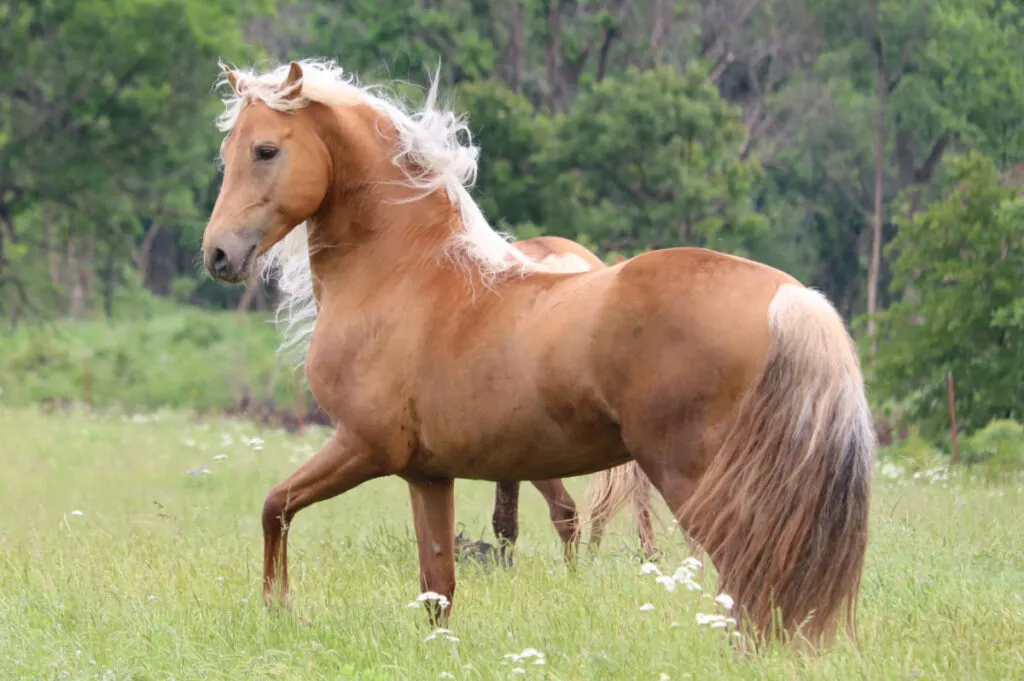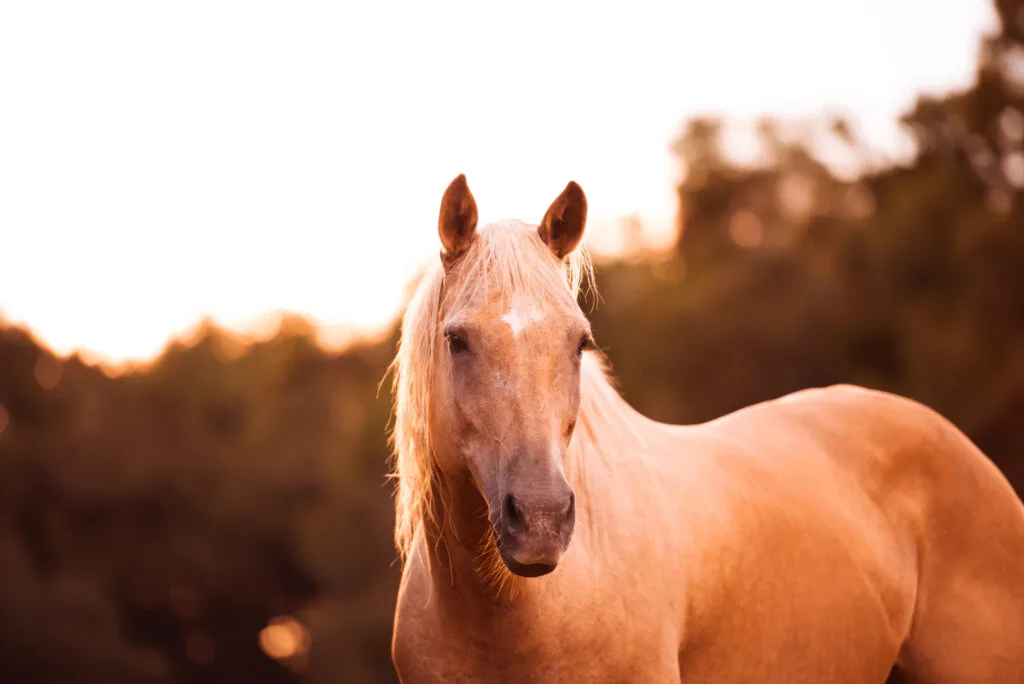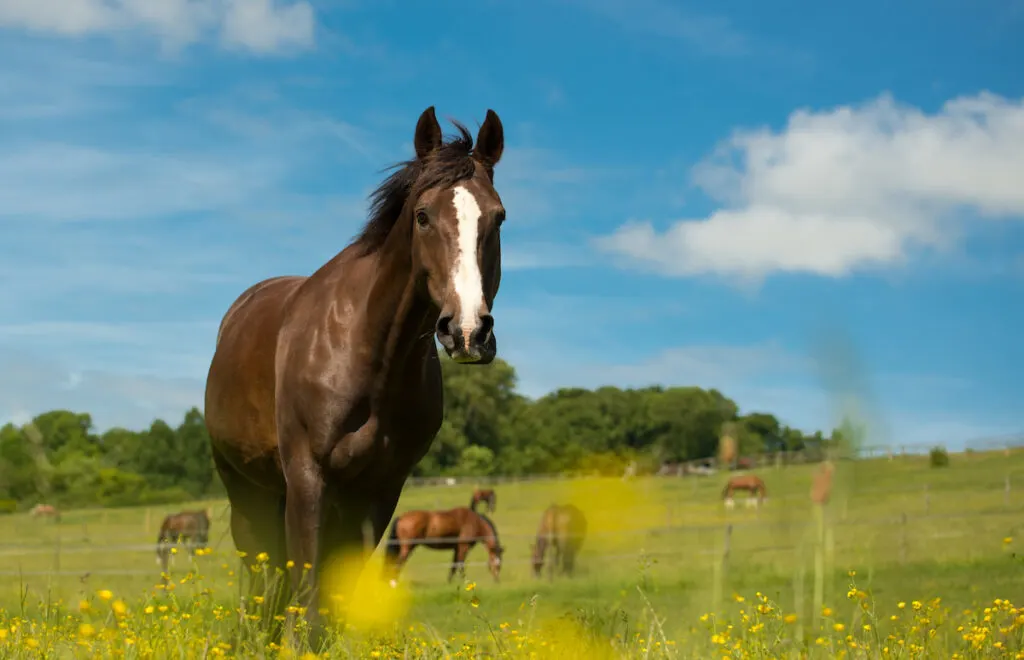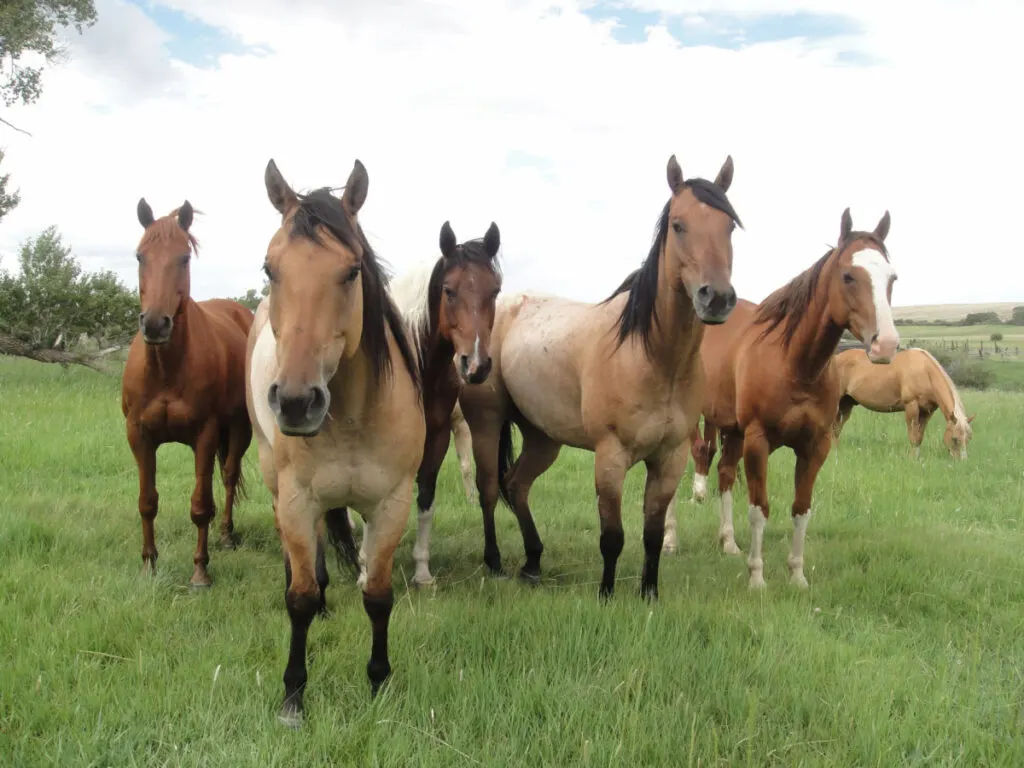Chocolate Palomino horses with a deep brown coat and white main & tail are some of the most striking horses you can find. Chocolate Palomino horses may also have a flaxen or gold-colored main and tail, along with their brown coat. Chocolate Palomino coloring isn’t breed-specific, instead, it’s a result of the horse’s genetics.
Table of Contents
Key Takeaways
- Chocolate palominos have a chestnut base coat genetically altered by a creme gene, resulting in their distinct color.
- The term “chocolate palomino” represents a spectrum of color variations, from a lighter, fawn palomino shade to a deeper, rich chocolate brown hue.
- Some display dapple or painted patterns, while the gold or cream mane/tail and dark coat is the signature of chocolate palominos specifically.
- Some display dapple or painted patterns, while the gold or cream mane/tail and dark coat is the signature of chocolate palominos specifically.
- Live Chocolate Palomino sale prices range from $3,000 to $8,500, and go up the more striking the coloring is, and the more skills the horse has.

Like all palominos, genetically, chocolate palominos have a chestnut base coat and a copy of the creme gene.
The creme gene “dilutes” the chestnut base and creates a golden color that ranges from light gold to the dark “chocolate” of chocolate palominos.
Chocolate palominos are not very common, but it’s worth learning about this wonderful color horse and how to distinguish it from other dark chestnut horses.
What Is a Chocolate Palomino Horse?
A palomino horse has a deep, dark golden coat with a white or very light yellow mane and tail. Often, however, chocolate palominos may have a few black or brown hairs in their mane and tail.
Like all palominos, chocolate palominos are a color type, not a breed.
A solid color chocolate palomino is rare to find. More commonly, a chestnut horse that has very pronounced sooty markings will be called a chocolate palomino.
Sooty palomino marks are darker shadings along the face, rump, topline, and shoulders that look as if the horse has been covered in soot! As the horse ages, the markings may spread from the toplines to the rest of the body.
What Color Is A Palomino Horse Typically?
Palomino refers to a horse color genetic pattern characterized by a yellow or gold coat, usually accompanied by a light cream mane and tail. They typically have dark skin and brown eyes, or pinkish skin that darkens with age. (Source)
A chocolate palomino is a special case where specific genes result in a brown or black coat with a highlighted tail or mane coloring. The rarity of these genetic color combinations makes chocolate palominos particularly special. (Source)
How Do You Breed A Palomino Horse?
The easiest way to produce a chocolate palomino foal is to breed a chestnut horse with a palomino. This pairing increases the likelihood of the offspring inheriting the necessary genetic combination. Typically, this has a 50% chance of producing a chocolate brown horse, but other horse colors might result.
Chocolate Palomino Horse Genetics

The genetic composition of chocolate palominos consists of a chestnut base coat (ee) and a copy of the cream dilution gene (nCr). (Source)
Horses that carry one copy of the dilution genes are identified as single dilutes. For example, a bay horse carrying a single copy of cream will be a buckskin, while a black horse carrying this single cream gene will be known as a smoky black.
A single dilute chestnut is known as a palomino. There is only a 50% chance that a single dilute horse will pass the cream gene to its offspring.
Chocolate palominos may also result from a pairing between a liver chestnut horse and a palomino.
In the world of horse colors, the chocolate palomino stands out as one of the most popular and is considered highly desirable. This color can be found in various horse breeds, including Morgan, Quarter Horse, and Tennessee Walking Horse. (Source) (Source)
Other variations like sooty palomino markings, which add darker shading to the coat, and the rare silver dapple gene, leading to silver dapple patterns, contribute to the unique appearance of these horses.
For more on horse genetics related to color, have a look at the video at timestamp below in which Dr. Rebecca Bellone, of the UC Davis Veterinary Genetics Laboratory, explains more about this topic:
Chocolate Palomino Horse Prices
You can have a look at sites like equinenow.com to find live horse price listings. Here’s a collection of a few listings on the site, so you can see example pricing of Chocolate Palominos and some other Palomino coloring examples:
| Listing Link/Horse (Live at time of writing) | Price | Notes |
| Big Strong Trail Deluxe Dapple Palomino Gilding, Tennessee Wa | $8,700 | Not quite as “chocolate” as some others |
| Beginner Palomino Tobiano | $3,000 | Classic Chocolate Palomino coloring |
| Palomino Rocky Mountain Mare | $8,500 | Classic Chocolate Palomino coloring |
| Gorgeous Dapple Palomino Super Gentle | $5,500 | An example of another coloring – dappled |
| Palomino Paint Mare | $4,500 | An example of another coloring – in this case paint. |
Chocolate Palomino Horse History
The history of the chocolate palomino, a genetic color variation within the palomino horse breeds, is as rich and varied as their stunning coat colors.
According to historical records, these horses were not only prized for their color but also for their versatility, frequently appearing in show rings and parades, and even in Hollywood during the 1940s and 1950s.
Chocolate Palomino Imposters
Silver Black
Silver black horses are often confused with chocolate palominos. Silver blacks are uniform gray or brown with manes and tails that range from a bleached appearance to silver or white. However, silver-black horses’ genetics are quite different from those of chocolate palominos’.
Silver black horses carry the silver gene, which has the effect of lightening the tail and mane and diluting the horse’s uniform black color to a chocolate shade. While chestnut horses can carry the silver gene, it doesn’t show in their appearance (source).
Liver Chestnut with Flaxen Mane and Tail

Another horse that may be confused with a chocolate palomino is a liver chestnut horse with a flaxen mane and tail. Liver chestnut is the darkest shade of chestnut you can find on a horse.
A chestnut horse that carries the flaxen gene (F) will have a light blond mane and tail. The flaxen gene can make the mane and tail of this horse appear flaxen (light blond), honey, ivory, or white (source).
Though the contrast between the dark coat and light mane and tail of this horse may remind one of a chocolate palomino, genetically, it cannot be classified as a palomino because it does not carry the cream gene (nCr).
Breeds Where You Can Find Chocolate Palomino Horses
Almost every horse breed can produce a palomino. In fact, the Palomino Horse Breeders of America (PHBA) recognizes 17 different blood breeds of horses (source).
Some of the most common breeds where you can find palominos include:
- Quarter Horses
- Tennessee Walking Horses
- American Saddle Horses
- Arabians
- Thoroughbreds
- Standardbreds
As palominos and chocolate palominos are much sought-after horses due to their incredible colors, they are often found in Western riding events such as rodeos in the US and Canada.

Among palominos, chocolate palominos are rare, so it may be more difficult to find chocolate palominos among any of these breeds.
A well-known chocolate palomino in the United States is Gold Sultana, an American Saddlebred and breeding stallion owned by Antigo American Saddlebreds in Bow, Washington. (source)
If you are the lucky owner of a chocolate palomino, you may be thinking of a great name for your horse. Take a look at this comprehensive list of palomino horse names to help you get inspired!
Related Reading
- Dapple Palomino Horse Photos, Breeds, and Where to Buy
- Blood Bay Horses
- Dun Horse Color — Description, Pictures, and Genetics
- 130+ Palomino Horse Names
Sources
When learning about horses, it is important to consult a wide variety of sources. These are the sources we used for this article.
- https://www.greatlakesmodelhorses.com/equine-color-genetics
- https://www.horse-genetics.com/palomino-horses.html
- https://www.animalgenetics.us/equine/coat_color/Cream.asp
- https://aminoapps.com/c/equestrian/page/blog/equine-genetics-cream-silver/QzgZ_3WIXupD45qBlMe2aRWQq8LRg5mLL
- https://www.horse-genetics.com/chestnut-horses.html#:~:text=The%20flaxen%20(F)%20gene%20is,and%20tail%20in%20chestnut%20horses.&text=If%20one%20or%20both%20of,then%20no%20pigment%20is%20made.
- https://www.palominoheritage.com/history/palomino-breeds
- http://palominosaddlebred.com/gold-suntana
- https://www.animalgenetics.us/equine/coat_color/Cream.asp

